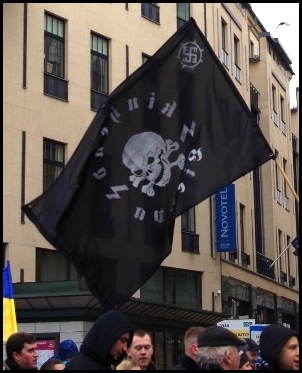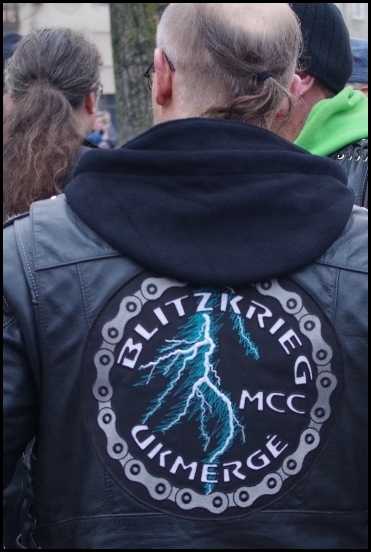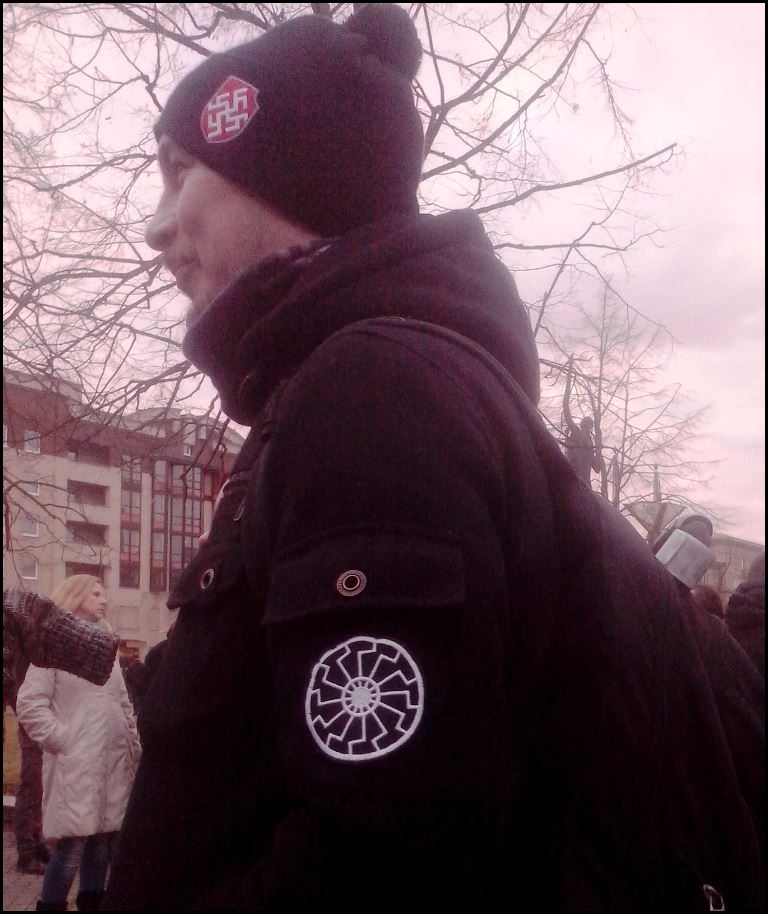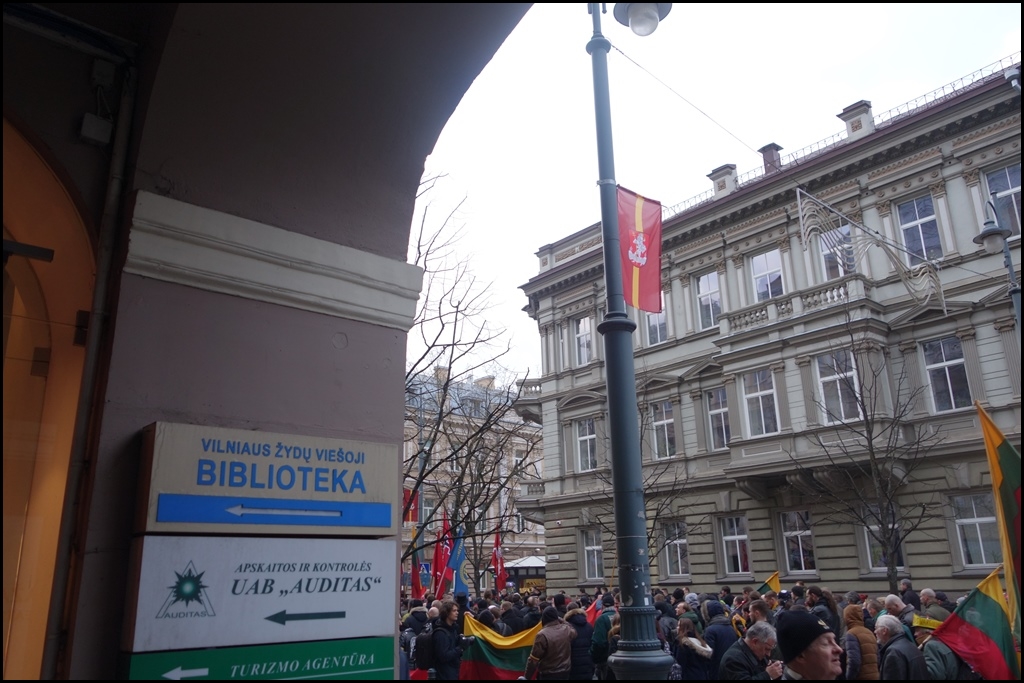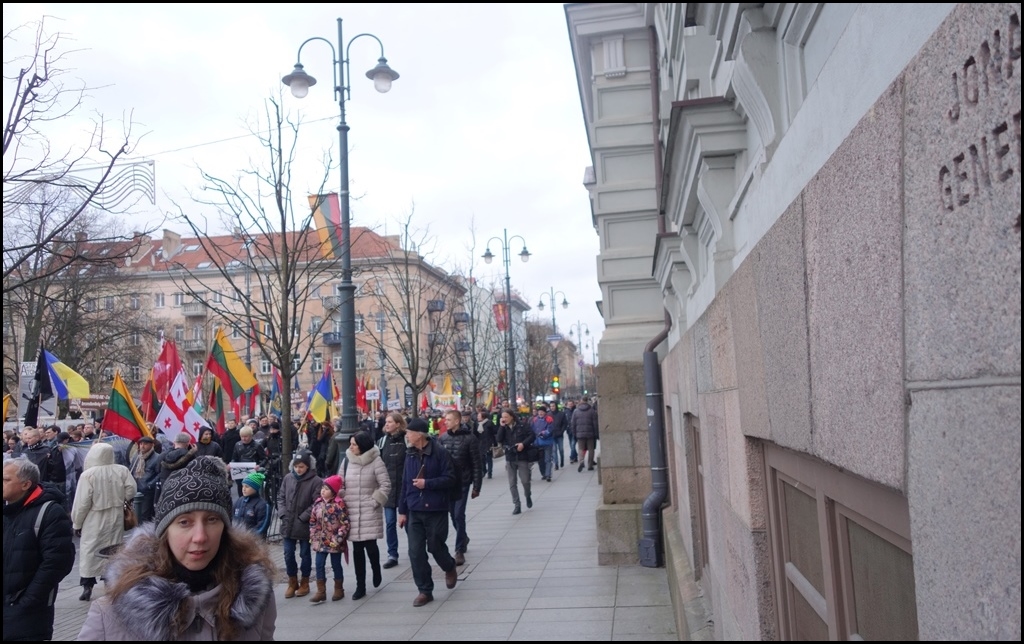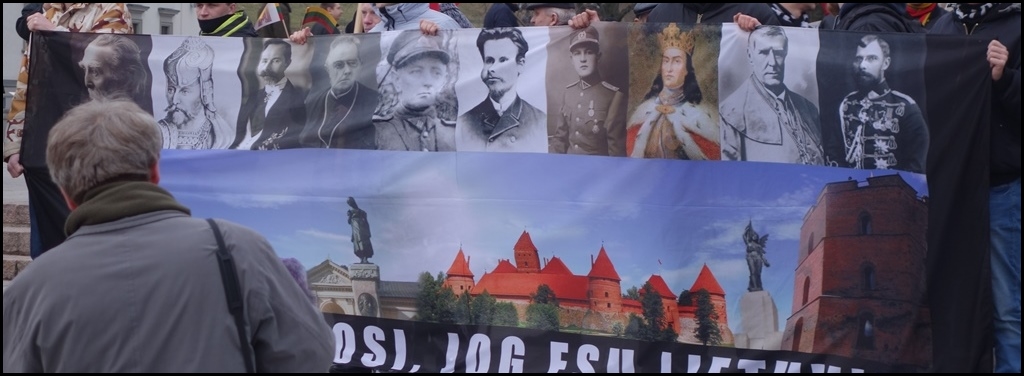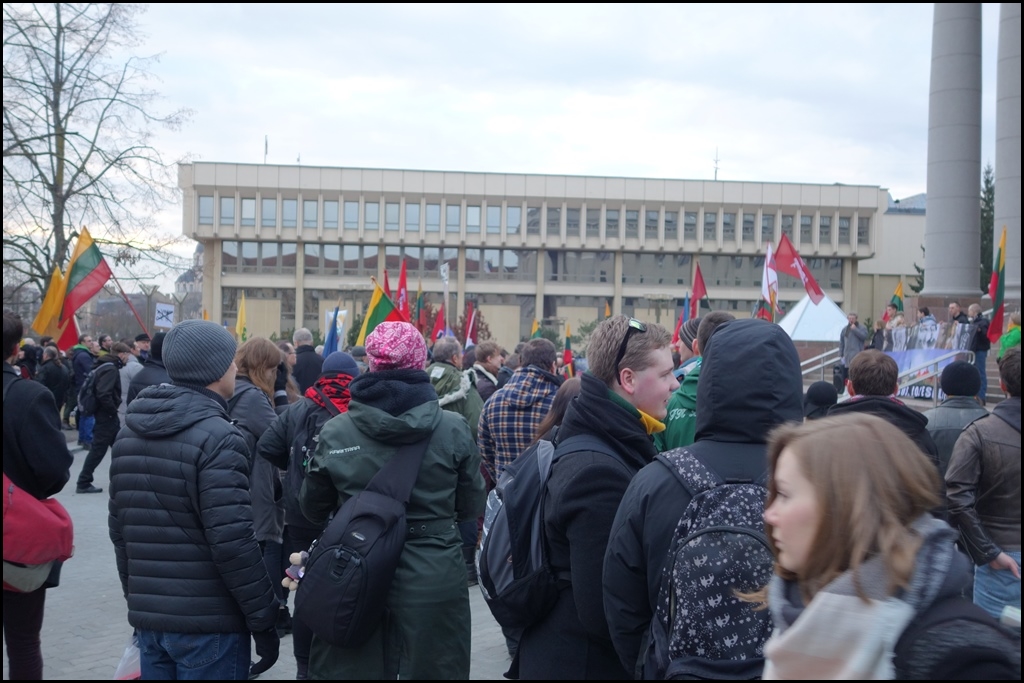[last update 14 March 2017]
HUMAN RIGHTS | ANTISEMITISM | NEO-NAZI MARCHES | IN VILNIUS | KAUNAS | RIGA
◊
by Dovid Katz
◊
VILNIUS—A six-person monitoring group assembled by Defending History was the only human rights team at this year’s March 11th neo-Nazi march in central Vilnius. DH’s monitors were Eveldas Balčiūnas, Dovid Katz, Julius Norwilla, Ruta Ostrovskaja, Jacob Piliansky, and Julia Rets. Two senior longtime annual observers, both major figures in Lithuania’s Jewish community for over half a century, Milan Chersonski and Prof. Pinchos Fridberg, were prevented by health issues from monitoring the event this year.
For years Defending History has asked that the marchers’ freedom of speech be respected at venues away from the center of the capital on the nation’s independence day. The granting of “that time and place” (only since 2008) conveys a sense of legitimization by both the municipality and national government, which are sometimes thought to be playing a “double game” by facilitating the honoring of Holocaust perpetrators locally, alongside commemorations for the victims for foreign consumption. At least two Western ambassadors were “quietly” among the observing crowds.
Photo Galleries:
Evaldas Balčiūnas; Julius Norwilla; Julia Rets; Alkas.lt; Delfi.lt. Did “mainstream media” coverage avoid imaging swastikas, other fascist symbols, and Hitler salutes?
Over 500 participants (less than in many previous years) were again granted (by the municipality and government) the most historically sacred sites of the nation’s capital, including the Cathedral, where the event started; the forecourt of the Presidential Palace, where a new event was added to denigrate 95 year old Holocaust survivor Fania Yocheles Brantsovsky; the entirety of the city’s main boulevard, Gedimino Boulevard, from the Cathedral Square where it started right up to the hallowed forecourts of the National Gallery and the Parliament (Seimas) where it concluded. There was a small group of about ten Lithuanian tolerance-campaigners who tried hard to be heard shouting Lietuva visiems (“Lithuania for Everybody”) from the sidelines in response to the organized marchers’ now-standard chant of Lietuva lietuviams (“Lithuania for Lithuanians”). This latter chant, on independence day in the heart of the city, rings all the more strange in a country with statistical zero of inward migration or refugees, and a once-renowned Jewish community that is now facing demographic extinction by approaching statistical zero, as a direct consequence of the Holocaust.
Nationalist symbols included swastikas, with “only” one of them on a large parade banner whose larger symbol was the skull and crossbones. The parade’s front banner, recycled from a number of previous years, included a number of national heroes, this year including “only several” alleged local Holocaust collaborators. There were “only several” episodes of Hitler salutes, which, like the swastikas, seemed not to make it into the “mainstream media” photo galleries of the event (e.g. Alkas.lt, Delfi.lt).
Around 96% of Lithuanian Jewry was murdered during the Holocaust, the largest proportion in wartime Europe, and with massive local collaboration by “heroes” still celebrated by street names and an array of events. By contrast, the rescuers (Righteous Among the Nations), whose inspirational bravery is an eternal pride to the Lithuanian people, have yet to be recognized adequately.
The event, organized by far right and neo-nazi elements making up the Tautininkų sąjunga (“Nationalist Union”), seemed incongruous with the March 11th holiday, one of the most positive, universally beloved days on the Lithuanian calendar, marking the day in 1990 when the nation’s parliament voted 124 to zero to declare independence from the Soviet Union. The courage and unanimity of the political parties, ranging from nationalist to nominal communist, helped hasten the demise of the Soviet Union. Fourteen innocent, peaceful demonstrators were mowed down by Soviet tanks in January 1991. For its part, the newly arisen democratic Lithuanian republic rapidly and generously granted Lithuanian citizenship to all the country’s residents, passed a democratic constitution and eventually achieved membership, in 2004, in both the European Union and NATO. It has baffled observers that the ultranationalists who disdain non-ethnic-Lithuanians and effectively celebrate the ethnic cleansing of the Holocaust, have been gifted the hallowed sites of the capital’s very center for their neo-nazi demonstrations since 2008. Defending History has been monitoring the annual event ever since, along with those in Kaunas, and the annual Waffen SS marches in Riga. Over the years, well-financed “human rights organizations” such as the Human Rights Monitoring Institute (HRMI) the have occasionally been taken to task for their failure to utter the mildest words of protest, let alone participating in monitoring the event. Some “human rights organizations,” such as the Lithuanian Human Rights Association (LHRA) have even joined antisemitic gang-ups on the Holocaust Survivors who joined the anti-Nazi partisans. Then there are those who become interested in Holocaust issues after a hefty grant, for example the Lithuanian Center for Human Rights (LCHR) after a 14,285 euro grant in 2015 from the scandal-ridden “Good Will Foundation” that disburses funds from the religious properties of the annihilated Jewish communities of Lithuania. But there was not a peep from them, either, in 2017, at the specter of a neo-Nazi march being given the center of the capital city on the nation’s Independence Day. The utter silence of the “human rights community” at such events, when it comes to events featuring neo-nazism, antisemitism or the glorification of Holocaust perpetrators, when sanctioned by municipal and state authorities, needs to be studied in its own right.
◊
A New Component of the Fascists’ Hijack of a Nation’s Independence Day: Revival of Defamation and Hate against Holocaust Survivors who Escaped the Ghetto to Join the Anti-Nazi Resistance
A bizarre addition to this year’s proceedings was the reading of an elaborate statement of defamation against 95 year old Vilnius resident Holocaust survivor Fania Yocheles Brantosvsky (Brancovskaja), one of the Jewish partisan veterans defamed by Vilnius prosecutors in an eleven-year old saga that has caused extensive damage to Lithuania’s reputation. The excuse this time was a recent award for Holocaust education to Ms. Brantsovsky from the president, Dalia Grybauskaitė, on 16 February, and the ultranationalists’ demand that the award be rescinded. A petition to that effect authored by Sakalas Gorodeckis was declaimed by Arūnas Eigirdas, with the beaming author standing by his side, and the presidential palace in the background. For this part of the festivities, the gathering crowd in Cathedral Square was invited early on to walk over to the Presidential Palace for the macabre Anti-Brantsovsky Ceremony. The statement can be heard from just after the six-minute mark on the video released:
The renewed campaign against Fania Brantsovsky and other Jewish partisans has been featured in recent days on Alkas.lt, Propatria.lt, Slaptai.lt, and other portals. In the rather immediate background of the many years of defaming the last Holocaust survivors stands the theory of “Double Genocide” which includes the corollary that victims are perpetrators and perpetrators are victims in the grand mix-and-match jumble of Holocaust Obfuscation. The national purveyors of the theory are the state’s “Genocide Center” and its taxpayer-sponsored “International Commission for the Evaluation of the Crimes of the Nazi and Soviet Occupational Regimes in Lithuania” (known as the “Red-Brown Commission”). The commission’s executive director has been very clear in public about Holocaust revisionism generally, and Ms. Brantsovsky specifically.
It was six years ago that former UK prime minister Gordon Brown paid tribute in the Independent to another of the defamed survivors, the late Dr. Rachel Margolis, and it was nine years ago that Ms. Brantsovsky, at the initiative of the team that would develop into Defending History, was honored by the ambassadors of Austria, France, Germany, Ireland, Norway, the United Kingdom, and the United States, among others. It was the first time in post-Soviet history that people trashed by local prosecutors in Eastern Europe, in the absence of evidence, and on the basis of ethnicity, were being honored by the embassies of the major democratic powers of the free world.
Throughout the now eleven year old campaign against Jewish partisans (the much greater number of non-Jewish veterans of the anti-Nazi Soviet partisans were not so much as mentioned by prosecutors), the inherent, intimate and constant link with a zoological strain of antisemitism has been exposed and explained by a wide variety of public figures. These include the now classic statements of the late chairperson of the Jewish Community of Lithuania, Dr. Shimon Alperovich, on 19 June 2008, and on 1 September 2008, in both cases in partnership with Tobijas Jafetas, chairperson of Lithuania’s Union of Former Ghetto and Concentration Camp Prisoners. The record includes powerful statements of then UK MP Denis MacShane, the late Sir Martin Gilbert, a group of US Congressmen, and many more international voices. Within Lithuania, there is consensus that the most poignant voice was that of the late philosopher and member of the European Parliament, Prof. Leonidas Donskis, in his 2008 essay on the links between state prosecutors’ interference with Fania Brantsovsky and Rachel Margolis and how it reflects on his country’s being, in his view, “intoxicated with hatred for the vanishing Lithuanian Jews.” That same year, Donskis called the investigations against Yitzhak Arad “the most severe mistake made by the Lithuanian government since independence.”
◊
An Independence Day’s Images and their Contextual Significance
Once again, the independence day cherished by the free world, marking the 11 March 1990 Declaration of Independence from nearly a half-century of Soviet occupational rule, was marred by swastikas and other fascist symbols flaunted with authorities’ approval in the very center of the capital. These include skill and crossbones, and the runic logo of “Deutsche Jungvolk,” the Hitler Youth organization for 10 to 14 year olds. An infamous 2010 case resulted in the legalization of swastikas in the country. It was clear to all during the parade that these swastikas were tributes neither to ancient Indian nor to prehistoric Baltic culture, but blatant statements of adoration of the precise Hitlerism that resulted in the mass murder of close to all of Lithuanian Jewry, now a near-extinct people even as empty, hollow “Litvak Culture” PR initiatives are unceasingly proclaimed and enacted.
Swastika flaunting on parade banners in city centers is not a quantitative issue, anymore than cockroaches in your spaghetti in a posh restaurant. It is a quintessentially moral issue. One swastika is quite enough to confer the shameful status of neo-nazism on all of the participants, organizers and supporters of the effort altogether. In the context of ground zero of the Holocaust, the flaunting of swastikas is invariably an expression of glee at the butchering of Lithuanian Jewry, and has been taken as such by survivors and their families, all the more so when collaborators and perpetrators are glorified in public spaces with state funding. [Thought experiment: a “workers’ parade” with “just one” sign calling for return of Soviet-Russian rule, that being a rather pale comparison to the accomplished genocide of Lithuanian Jewry under the unifying symbol of Hitler’s regime.]
◊
There were repeated brief outbursts of Hitler salutes coming from various parts of the march, reflecting care, it seemed, that not more than one from a smallish group should be evident at the same time. Like the swastikas, these were missed by most of the “mainstream media” photo galleries that seemed intent on sanitizing the event.
◊
Once again, the march passed by the “Vilnius Public Jewish Library.” There was not the slightest peep of protest from the Library’s personnel. With few exceptions, the many Holocaust-related events hosted by the library have been in the service of the Genocide Center and the state’s “International Commission for the Evaluation of the Crimes of the Nazi and Soviet Regimes of Lithuania.” The “Jewish” library continues its perfect record of never hiring a single Jewish employee. Try that one out for an African-American Library out in Alabama.
◊
Each year, the neo-nazi procession passes by the Genocide Center’s engraved stone block glorifying Nazi collaborator and perpetrator Jonas Noreika. On the subject of public Noreika adoration, see also the saga of the 2015 petition by a group of Lithuanian intellectuals, that year’s protest at another Noreika plaque in town by the country’s (tiny) Union of Jewish Students, and a Jerusalem Post article by Grant Gochin. More recently, in Nov. 2016, the official Lithuanian Jewish Community’s chairperson Faina Kukliansky wrote to authorities on the subject of Noreika.
◊
The parade’s front banner included “only” several alleged Holocaust collaborators, among them Jonas Žemaitis (fifth from left) and Adolfas Ramanauskas-Vanagas (seventh). The question is not of the historical debates around each, or what would have been his guilt or innocence at trial, but of the message being sent when these are among those glorified on the modern democracy’s cherished independence day in the context of flaunted swastikas, broadsides against the nation’s oldest Holocaust survivor, and fascist taunts of “Lithuania for Lithuanians.” Needless to say, rescuers have never figured as heroes here. In earlier years, before international pressure forced omission of direct antisemitic and racist chants, these were loudly featured, and duly recorded for posterity.
◊
Yet again, the neo-nazis’ parade was permitted to conclude at Parliament Square, in the forecourt of the very Seimas (parliament) building that is the symbol of the nation’s successful democracy, and where, indeed, the Declaration of Independence was proclaimed on 11 March 1990. Surely the president, prime minister, mayor of the capital and other high officials can be made to understand that the huge achievement of that magnificent democracy is not honored by granting its prime symbols to those who would use them on independence day to flaunt swastikas, Holocaust collaborators, fascist slogans and hate to the death of the very last, very few Litvaks guilty of — surviving. Is that really how authorities now wish to say farewell to seven hundred years of Lithuanian Jewish history?
